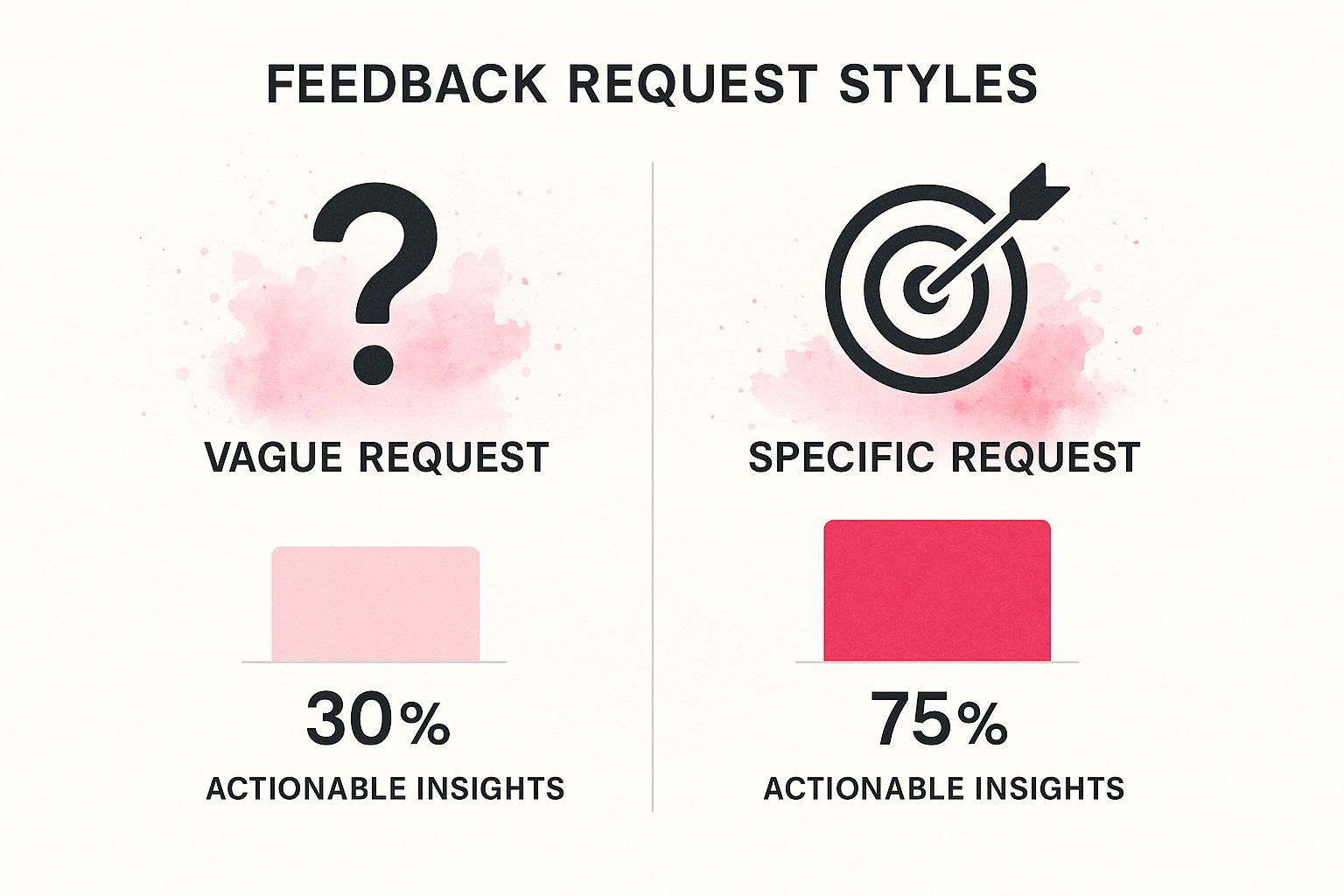How to Ask for Feedback at Work and Get It
Max
Figuring out how to ask for feedback at work really comes down to a few core things: knowing your goal, picking the right person and moment, asking specific questions, truly listening without getting defensive, and then following up with thanks and a plan. It’s a simple process, but shifting from passively waiting for annual reviews to actively seeking input puts you firmly in the driver’s seat of your own career.
Why Proactive Feedback Is Your Career Growth Engine

Let’s be honest, asking for feedback can feel a little intimidating. But what if you saw it not as a critique, but as the single most powerful tool you have for professional growth? Waiting for a once-a-year review is a surefire way to stagnate. Grabbing the reins of the feedback conversation is how you fast-track your learning and stay ahead of the curve.
This proactive mindset is especially vital because of a huge perception gap in most workplaces. While tons of employees say they want regular input, it’s just not happening. For managers, figuring out how to deliver this is key, especially when it comes to conducting remote performance reviews and handling day-to-day check-ins.
A Gallup study really highlights this gap. Only about 20% of employees get feedback every week. What’s telling is that 43% of highly engaged employees receive weekly feedback, compared to just 18% of those with low engagement. The link is crystal clear.
Sidestep Blind Spots and Gain Clarity
Without seeking out feedback, you’re basically driving your career with a foggy windshield. You might think your presentations are killer, but a trusted colleague could offer one small tweak that makes them twice as effective. You just don’t know what you don’t know.
Seeking input helps you:
- Catch hidden weaknesses before they snowball into bigger problems.
- Get a clear picture of how others see your contributions.
- Build stronger relationships grounded in trust and mutual respect.
This is fundamental in any office, but it’s even more critical when you’re working remotely. When you aren’t sharing a physical space, proactively https://remotefirstjobs.com/blog/building-trust-in-virtual-teams through open communication is non-negotiable.
To make this easier, here’s a quick breakdown of the process.
Quick Guide to Asking for Feedback
This table simplifies the feedback request process into three distinct phases, from preparation to follow-through.
| Phase | Key Action | Example |
|---|---|---|
| Preparation | Define a specific goal for the feedback. | “I want to know if my explanation of the Q3 data in yesterday’s presentation was clear to the non-technical stakeholders.” |
| The Ask | Be direct, provide context, and ask targeted questions. | “Hey Alex, do you have 15 minutes next week? I’d love your feedback on the project proposal I sent over, specifically on the budget section.” |
| Follow-Up | Express gratitude and create a tangible action plan. | “Thanks so much for the feedback! I’m going to revise the budget layout and add the chart you suggested. I really appreciate your time.” |
By consistently making these small, intentional requests, you create a culture where transparent dialogue is the default, helping everyone get better together. This one habit is the engine that will power your career forward.
Setting the Stage for Meaningful Conversations

Great feedback doesn’t just happen. It’s the direct result of thoughtful preparation. Before you even think about how to ask for feedback, you need to lay the groundwork. This initial prep is what separates vague, unhelpful platitudes from the kind of advice that can genuinely shape your career.
It starts with a bit of self-reflection. Forget the generic “How am I doing?” and get specific about an area you want to grow. Are you trying to sharpen your project management skills? Maybe you want to know if your contributions in team meetings are hitting the mark. A clear focus makes it infinitely easier for others to give you something concrete to work with.
Choose Your Person and Your Moment
The right person isn’t always your direct manager. Think about peers who see your day-to-day work up close or mentors who can offer a completely different perspective. A teammate might give you tactical feedback on a shared project, while a senior colleague from another department can provide high-level strategic advice.
Timing and context are just as crucial. Ambushing someone during a chaotic week is a recipe for a rushed, unhelpful response. Instead, look for natural openings to make your ask.
- After a project retrospective: This is a perfect time to get specific input on your performance during that project cycle.
- During a one-on-one: Use this dedicated time to dig into a skill you’re actively trying to develop.
- Following a presentation: Ask for immediate impressions on your delivery while it’s still fresh in everyone’s mind.
The environment you foster is just as important. In fact, cultivating psychological safety is the bedrock of candid feedback, ensuring people feel secure enough to be honest. This foundation of trust is especially critical during processes like remote onboarding, where setting clear communication norms from day one is essential. We dive deeper into these strategies in our guide to remote employee onboarding best practices.
The data really drives home why this prep work matters. While over 75% of employees say frequent feedback is vital, less than 30% actually get it regularly. But here’s the kicker: employees who feel heard are 4.6 times more likely to excel, and companies with a strong feedback culture see nearly 15% lower turnover. You can find more details in these employee feedback statistics on attotime.com.
How to Phrase Your Request for Actionable Advice
The quality of the feedback you get almost always mirrors the quality of the question you ask. Let’s be honest, a generic “Do you have any feedback for me?” is a surefire way to get an equally generic, “Nope, you’re doing fine.”
To get real, actionable insights, you have to be more specific. It’s about being intentional.
Learning how to ask for feedback is really about shifting your approach. You need to move from vague, backward-looking questions to specific, forward-looking ones. This invites a constructive dialogue instead of a simple thumbs-up or thumbs-down. Rather than just asking how something went, pinpoint exactly what you want to improve.
Go From Vague to Valuable
This is a small but powerful change. You’re giving the other person a clear target to aim for, which makes their job of providing helpful feedback much, much easier.
Think about it this way:
- Instead of: “How did that meeting go?”
- Try This: “When I presented the Q3 data in today’s meeting, was my explanation clear for the non-technical folks? What’s one thing I could do to make it more persuasive next time?”
See the difference? The second version gives your colleague context and directs them toward a particular behavior you’re trying to strengthen.
The data backs this up. Moving from a vague question to a specific one can dramatically increase the likelihood of receiving useful advice.

As the chart shows, specific requests yield more than double the actionable insights compared to vague ones. That’s a huge jump from just 30% to 75%.
The way you frame your request can be the difference between getting a helpful tip and a polite nod. To help you get started, let’s look at some examples of how to turn those common, vague questions into specific, high-value ones.
From Vague to Valuable Feedback Requests
| Instead of This (Vague) | Try This (Specific) |
|---|---|
| “Any feedback on my presentation?” | “Was my core message about the budget forecast clear in the final two slides?” |
| “How am I doing on this project?” | “What’s one thing I could do differently to make our weekly check-ins more efficient?” |
| “Can you look over this draft?” | “I’m worried the tone in the introduction might be too formal. What are your thoughts on that section?” |
| “Do you think I’m ready for more responsibility?” | “I’m aiming to lead a project independently next quarter. What skill should I focus on developing to be ready for that?” |
By providing a clear starting point, you make it easier for others to give you the exact insights you need to grow.
More Examples of Powerful Phrasing
Here are a few more battle-tested phrases you can adapt, whether you’re talking to your manager or a peer.
“I’m working on improving my project management skills. What’s one thing you noticed during the launch last week that I could have organized more effectively?”
This question is so effective because it’s non-confrontational and focuses on a specific skill. It also signals that you’re genuinely committed to growth.
Ultimately, it frames the feedback as a collaborative effort to help you get better. This makes the other person feel less like a judge and more like a trusted advisor. By using this direct and focused method, you’ll start getting the kind of advice you need to really excel in your role.
Receiving Feedback Without Getting Defensive

Alright, you’ve done the hard part and asked for feedback. Now it’s time to receive it. This is the moment where real growth happens, and honestly, how you react will determine if you get this kind of candid input ever again.
Let’s be real—the first instinct for most of us is to get defensive. Your heart might start pounding, and you’ll feel an immediate urge to jump in and explain yourself. The most powerful thing you can do in that moment is pause. Just take a breath, listen, and try to focus on the good intention behind the words, even if the delivery isn’t perfect.
Practice Active Listening
Active listening isn’t just about shutting up while the other person talks; it’s about showing them they’ve been heard. One of the best ways I’ve found to do this is to simply paraphrase what they just said. It proves you’re actually processing their input and gives them a chance to clarify any misunderstandings.
For instance, you could try saying something like:
- “So what I’m hearing is that my report was detailed, but a better upfront summary would make it more impactful for leadership?”
- “It sounds like you feel my contributions in meetings would be stronger if I offered more data to back up my points. Is that right?”
This little trick keeps you engaged and, more importantly, stops you from launching into a defensive monologue. Learning to manage that knee-jerk reaction is a game-changer, and there are plenty of solid strategies for how you handle criticism that can help you master this skill.
The goal isn’t to challenge the critique but to truly understand it. Ask clarifying questions that seek more information, not questions that poke holes in their argument. Instead of “Why do you think that?” try “Could you give me an example of when you noticed that?”
And finally, always, always close the loop with genuine gratitude. A simple, “Thank you so much for taking the time to share this with me,” goes a long way. It builds trust and makes it more likely they’ll feel comfortable being honest with you next time.
Turning Advice into a Tangible Action Plan
So, you’ve gathered some great feedback. Now what? Honestly, feedback is just data until you actually do something with it. This final step is what separates passive listeners from the high-achievers who consistently grow in their roles. It’s all about turning that valuable advice into a concrete roadmap for improvement.
Start by looking at the big picture, especially if you asked multiple people. Are there any recurring themes? If three different colleagues mentioned your reports could be more concise, that’s a pretty clear signal. Don’t try to fix everything at once—that’s a recipe for burnout. Instead, zero in on the one or two areas that will make the biggest impact on your performance right now.
Create Your Simple Action Plan
Now it’s time to build a simple, no-nonsense plan with goals you can actually measure.
Let’s say the feedback pointed to a need to improve your meeting presence. A simple plan might look like this:
- Action 1: Before every team meeting, I will prepare one key talking point or question.
- Action 2: I will make a conscious effort to speak up within the first 15 minutes of the meeting.
See how specific that is? To really make this stick, mastering meeting notes and action items is a game-changer. It creates clarity and holds you accountable for following through.
This proactive approach is becoming essential. The days of waiting for an annual review are long gone. In fact, nearly 80% of employees now want feedback delivered in real-time, and about 60% are looking for it weekly, if not daily. For Gen Z, this often looks like quick, five-minute check-ins. You can dig into these evolving expectations in this research about employee feedback on zavvy.io.
The final, and arguably most important, step is to circle back with the person who gave you the feedback. A quick message like, “Thanks again for the advice on my presentation skills. I’m now practicing my openings beforehand,” does two things. It shows their input mattered and that you are genuinely committed to growth.
This entire process is a core part of working effectively in a remote setting. For more strategies on staying productive and connected, check out our guide on remote work best practices.
Common Feedback Questions Answered
Let’s be honest: even when you know you should ask for feedback, navigating the actual conversation can feel awkward. Real-world situations are rarely as clean as the advice columns make them out to be. So, let’s tackle some of those tricky, “what do I actually say?” moments that pop up all the time.
What If My Manager Is Always Too Busy?
We’ve all been there. Your manager’s calendar is a sea of back-to-back meetings, and you can’t find a gap. When they’re constantly swamped, the key is to make your request incredibly easy for them to say “yes” to.
Don’t just send a vague “can we chat?” message. Instead, take the initiative and book a specific 15-minute slot directly in their calendar. Give it a clear, direct title like, “Quick 15-min chat about my approach on the X project.”
Then, show up with one or two targeted questions ready to go. By doing the heavy lifting and showing you respect their time, you’re far more likely to get their full attention and the valuable input you’re after.
Don’t Agree with the Feedback? Here’s What to Do Your first instinct might be to defend yourself, but bite your tongue. The best first move is just to listen. Thank them for being direct, then give yourself space to really process it. Is there a kernel of truth you’re missing? Could it be about a perception you were totally unaware of? If you’ve mulled it over and still feel it’s off-base, ask a trusted colleague for a second opinion. This helps you figure out if it was a one-off comment or a genuine blind spot you need to work on.
How to Ask for Feedback After a Failed Project
Asking for feedback after a project goes sideways takes guts, but it also shows incredible maturity and a commitment to growth. The trick is to frame the conversation around learning, not blame.
Try saying something like, “I know the X project had its challenges, and I’m really focused on learning from the experience. From your perspective, what’s one thing I could have handled differently to help improve the outcome?”
This immediately positions you as accountable and forward-thinking—qualities any good manager values. It also helps create a more positive, collaborative culture where it’s safe to learn from mistakes. Fostering that kind of open communication is a huge part of improving remote employee engagement and building a team that bounces back stronger.
Should I Ask My Peers for Their Opinions?
Absolutely! In fact, you should. Peer feedback is a goldmine. Your colleagues in the trenches often have a more direct and tactical view of your day-to-day work than your manager does. They see you in action and can offer incredibly practical, on-the-ground insights.
Keep it collaborative and low-pressure. You could say, “Hey, since we worked on that presentation together, I’d love to get your take on my delivery. Is there anything I could do to support the team better in those situations?” This isn’t just about getting feedback; it’s about building trust and strengthening your working relationships.
Ready to find a role where your growth is a priority? Remote First Jobs connects you with thousands of verified, remote-first companies that value professional development. Explore over 40,000 open positions today!


